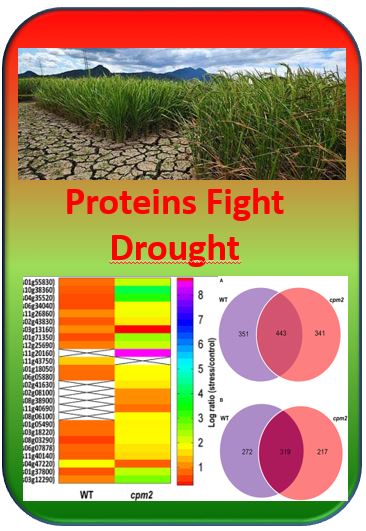2018_01: Proteome of Drought
What is the topic
Drought is one of the major challenges for agriculture, especially in cereals such as rice and wheat that are the staple food for many people. Genetic factors that help to breed crops with improved drought tolerance are also important to safeguard water as central resource. We were able to show that jasmonic acid, the “adrenalin of plants” is crucial for the activation of drought tolerance. We discovered rice mutants, where jasmonate cannot be produced. These mutants turned out to be salt tolerance. Since salt and drought tolerance overlap in many aspects, we hoped that, by using these mutants, we might address molecular factors contributing to drought tolerance.
What did we find?
In face, we could show, both in laboratory experiments at KIT, as well as in field studies at the International Rice Research Institute (IRRI) on the Philippines that these mutants coped better with drought stress, which was linked with an improved root system. On this base, we searched for differences in proteins under mild or severe drought. Using a mass spectroscopical detection technology, hundreds of proteins could be identified and compared, such that the patterns could be filtered by bioinformatics tools to assign them to specific events in the cell. For instance, we found that the mutant more efficiently scavenged reactive oxygen species (a important factor for drought tolerance) or that it mobilised energy resources more efficiently. There were also some surprises: for instance, the mutants were seen to produce more precursors for lignin, the wood substance, and to modify their cell wall. Further, the enzyme OPDA-Reductase 7, driving a biosynthetic step in the production of jasmonic acid, was found to act as important switch that will decide, whether the precursor OPDA accumulates or is converted to jasmonic acid. This precursor has been recognised as signal of its own virtue that can activate programmed cell death (to sacrifice the leaves can help to protect the sensitive meristem, which will help the plant to regenerate, once the drought is over).
What can be done with this knowledge?
One might try to use genetic engineering to change the "hardware" of the plant and to promote or dampen some of the factors identified here. Our idea is to use a different path: we rather want to change the "software” by improving the regulation of drought tolerance. This does not require to introduce new genes, that were absent from the plant. Rather, the temporal pattern of the existing genes have to be adjusted. This can be achieved by making use of the natural diversity, already present in the plant and recombine it in an improved manner by "natural" crossing, supported and accelerated by molecular analysis (marker-assisted or smart breeding). Especially the enzyme OPDA Reductase seems to be a good lever for this strategy.
Publication
Dhakarey R, Raorane ML, Treumann A, Peethambaran PK, Schendel RR, Sahi VP, Hause B, Bunzel M, Henry A, Kohli A, Riemann M (2017) Physiological and Proteomic Analysis of the Rice Mutant cpm2 Suggests a Negative Regulatory Role of Jasmonic Acid in Drought Tolerance. Front Plant Sci 8, 1903 - pdf

